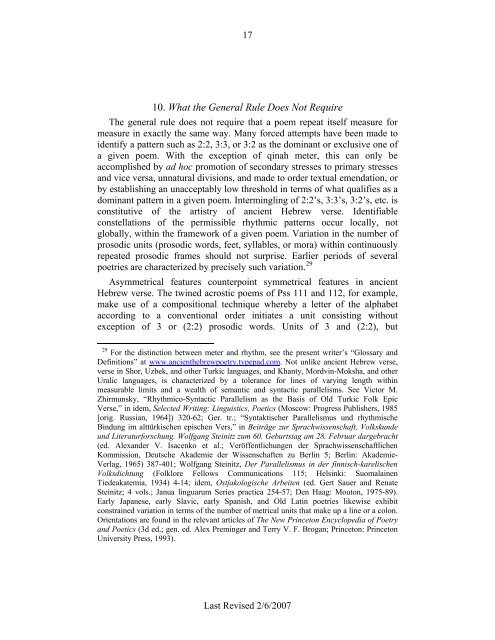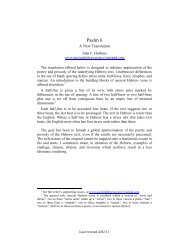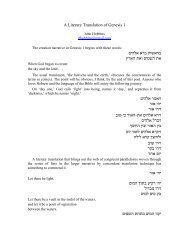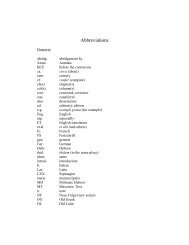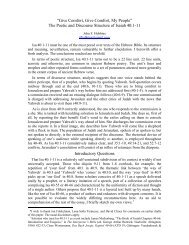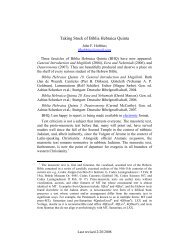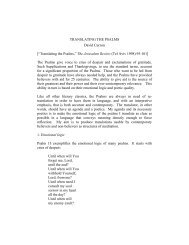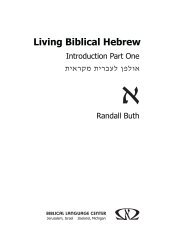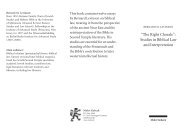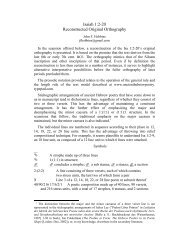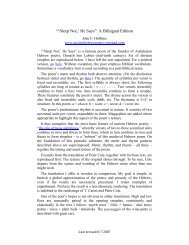Hebrew Poetry - Ancient Hebrew Poetry - Typepad
Hebrew Poetry - Ancient Hebrew Poetry - Typepad
Hebrew Poetry - Ancient Hebrew Poetry - Typepad
You also want an ePaper? Increase the reach of your titles
YUMPU automatically turns print PDFs into web optimized ePapers that Google loves.
1710. What the General Rule Does Not RequireThe general rule does not require that a poem repeat itself measure formeasure in exactly the same way. Many forced attempts have been made toidentify a pattern such as 2:2, 3:3, or 3:2 as the dominant or exclusive one ofa given poem. With the exception of qinah meter, this can only beaccomplished by ad hoc promotion of secondary stresses to primary stressesand vice versa, unnatural divisions, and made to order textual emendation, orby establishing an unacceptably low threshold in terms of what qualifies as adominant pattern in a given poem. Intermingling of 2:2’s, 3:3’s, 3:2’s, etc. isconstitutive of the artistry of ancient <strong>Hebrew</strong> verse. Identifiableconstellations of the permissible rhythmic patterns occur locally, notglobally, within the framework of a given poem. Variation in the number ofprosodic units (prosodic words, feet, syllables, or mora) within continuouslyrepeated prosodic frames should not surprise. Earlier periods of severalpoetries are characterized by precisely such variation. 29Asymmetrical features counterpoint symmetrical features in ancient<strong>Hebrew</strong> verse. The twined acrostic poems of Pss 111 and 112, for example,make use of a compositional technique whereby a letter of the alphabetaccording to a conventional order initiates a unit consisting withoutexception of 3 or (2:2) prosodic words. Units of 3 and (2:2), but29 For the distinction between meter and rhythm, see the present writer’s “Glossary andDefinitions” at www.ancienthebrewpoetry.typepad.com. Not unlike ancient <strong>Hebrew</strong> verse,verse in Shor, Uzbek, and other Turkic languages, and Khanty, Mordvin-Moksha, and otherUralic languages, is characterized by a tolerance for lines of varying length withinmeasurable limits and a wealth of semantic and syntactic parallelisms. See Victor M.Zhirmunsky, “Rhythmico-Syntactic Parallelism as the Basis of Old Turkic Folk EpicVerse,” in idem, Selected Writing: Linguistics, Poetics (Moscow: Progress Publishers, 1985[orig. Russian, 1964]) 320-62; Ger. tr.; “Syntaktischer Parallelismus und rhythmischeBindung im alttürkischen epischen Vers,” in Beiträge zur Sprachwissenschaft, Volkskundeund Literaturforschung. Wolfgang Steinitz zum 60. Geburtstag am 28. Februar dargebracht(ed. Alexander V. Isacenko et al.; Veröffentlichungen der SprachwissenschaftlichenKommission, Deutsche Akademie der Wissenschaften zu Berlin 5; Berlin: Akademie-Verlag, 1965) 387-401; Wolfgang Steinitz, Der Parallelismus in der finnisch-karelischenVolksdichtung (Folklore Fellows Communications 115; Helsinki: SuomalainenTiedeakatemia, 1934) 4-14; idem, Ostjakologische Arbeiten (ed. Gert Sauer and RenateSteinitz; 4 vols.; Janua linguarum Series practica 254-57; Den Haag: Mouton, 1975-89).Early Japanese, early Slavic, early Spanish, and Old Latin poetries likewise exhibitconstrained variation in terms of the number of metrical units that make up a line or a colon.Orientations are found in the relevant articles of The New Princeton Encyclopedia of <strong>Poetry</strong>and Poetics (3d ed.; gen. ed. Alex Preminger and Terry V. F. Brogan; Princeton: PrincetonUniversity Press, 1993).Last Revised 2/6/2007


